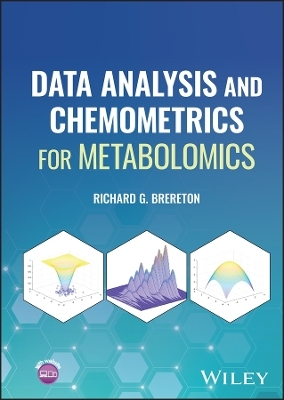
Data Analysis and Chemometrics for Metabolomics
John Wiley & Sons Inc (Verlag)
9781119639381 (ISBN)
Metabolomics is the study of metabolites, small molecules and chemical substrates within cells or larger structures which collectively make up the metabolome. The field of metabolomics stands to benefit enormously from chemometrics, an approach which brings advanced statistical techniques to bear on data of this kind.
Data Analysis and Chemometrics for Metabolomics constitutes an accessible introduction to chemometric techniques and their applications in the field of metabolomics. Thoroughly and accessibly written by a leading expert in chemometrics, and printed in full-colour, it brings robust data analysis into conversation with the metabolomic field to the immense benefit of practitioners.
Data Analysis and Chemometrics for Metabolomics readers will also find:
Statistical insights into the nature of metabolomic hypothesis testing, validation, and more
All metabolomics data sets from the book on a companion website
Case studies from human, animal, plant and bacterial biology
Data Analysis and Chemometrics for Metabolomics is ideal for practitioners in the life sciences, clinical sciences and chemistry, as well as metabolomics researchers or developers of research instruments looking to apply cutting-edge analytical techniques, and statisticians developing methods to design experiments and analyse large datasets of clinical and biological origin.
Richard G. Brereton, PhD, is Professor Emeritus at the University of Bristol, UK, and Director of Brereton Consultancy. He has published widely on chemometrics and related subjects, and serves as Editor-in-Chief for Heritage Science.
Foreword xi
Acknowledgements xv
About the Companion Website xvii
CHAPTER 1 Introduction 1
1.1 Chemometrics 1
1.2 Metabolomics 9
1.3 Case Studies 14
1.4 Software 15
CHAPTER 2 Instrumental Methods 26
2.1 Introduction 26
2.2 Coupled Chromatography Mass Spectrometry 27
2.3 Single Wavelength HPLC 47
2.4 Nuclear Magnetic Resonance 50
2.5 Vibrational Spectroscopy 61
CHAPTER 3 Case Studies 66
3.1 Introduction 66
3.2 Case Study 1: Presymptomatic Study of Humans with Rheumatoid Arthritis Using Blood Plasma and LCMS 67
3.3 Case Study 2: Diagnosis of Malaria in Human Blood Plasma of Children Using GCMS 69
3.4 Case Study 3: Measurement of Triglyclerides In Children's Blood Serum Using NMR 70
3.5 Case Study 4: Glucose Intolerance and Diabetes in Humans as Assessed by Blood Serum Using NMR 71
3.6 Case Study 5: Metabolic Changes in Maize Due to Cold as Assessed By NMR 72
3.7 Case Study 6: Effect of Nitrates on Different Parts of Wheat Leaves as Analysed by FTIR 74
3.8 Case Study 7: Rapid Discrimination of Enterococcal Bacteria in Faecal Isolates by Raman Spectroscopy 75
3.9 Case Study 8: Effects of Salinity, Temperature and Hypoxia on Daphnia Magna Metabolism as Studied by GCMS 76
3.10 Case Study 9: Bioactivity in a Chinese Herbal Medicine Studies Using HPLC 77
3.11 Case Study 10: Diabetes in Mice Studied by LCMS 78
CHAPTER 4 Principal Component Analysis 80
4.1 A Simple Example: Matrices, Vectors and Scalars 80
4.2 Visualising the Data Direct 81
4.3 Principal Components Analysis: Scores, Loadings and Eigenvalues 84
4.4 Exploration by PCA of Case Study 5 in Detail: NMR Studyof the Effect of Temperature on Maize 92
4.5 PCA of Different Case Studies 98
4.6 Transforming the Data 114
4.7 Common Issues 144
CHAPTER 5 Statistical Basics 151
5.1 Use of P Values and Hypothesis Testing 151
5.2 Distributions and Significance 152
5.3 Multivariate Calculation of P Values and the Mahalanobis Distance 182
5.4 Discriminatory Variables 190
5.5 Conclusions 194
CHAPTER 6 Choosing Samples 195
6.1 Motivation 195
6.2 Design of Experiments 196
6.3 Sampling Designs 206
CHAPTER 7 Determining the Provenance of a Sample 210
7.1 Pattern Recognition 210
7.2 Preliminary Processing Prior to Classification 211
7.3 Simulated Case Studies 212
7.4 Two-Class Classifiers 218
7.5 One-Class Classifiers 244
7.6 Multiclass Classifiers 272
7.7 Validation, Optimisation and Performance Indicators 288
CHAPTER 8 Multivariate Calibration 305
8.1 Introduction 305
8.2 Partial Least Squares Regression 306
8.3 Training and Test Sets 310
8.4 Optimisation: Number of PLS Components 317
CHAPTER 9 Selecting the Most Significant Variables and Markers 320
9.1 Introduction 320
9.2 Univariate Approaches 320
9.3 Loadings, Weights and VIP Scores 324
9.4 Selectivity Ratios 346
9.5 Volcano Plots 349
CHAPTER 10 Which Factors are Most Significant 352
10.1 Introduction 352
10.2 Terminology and Definitions 353
10.3 Single Factor (One-Way - One-Factor) ANOVA Test and Regression 357
10.4 Multiple Factor (Multiway) ANOVA Test and Regression 379
10.5 ASCA 389
Index 406
| Erscheinungsdatum | 05.05.2023 |
|---|---|
| Verlagsort | New York |
| Sprache | englisch |
| Maße | 178 x 254 mm |
| Gewicht | 1049 g |
| Themenwelt | Naturwissenschaften ► Biologie |
| Naturwissenschaften ► Chemie ► Organische Chemie | |
| ISBN-13 | 9781119639381 / 9781119639381 |
| Zustand | Neuware |
| Informationen gemäß Produktsicherheitsverordnung (GPSR) | |
| Haben Sie eine Frage zum Produkt? |
aus dem Bereich


